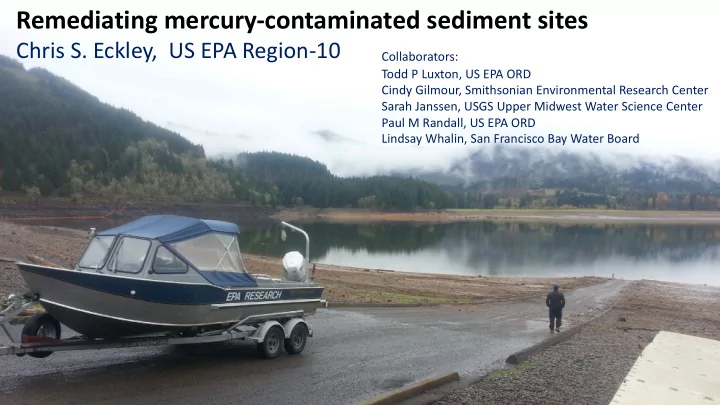

Remediating mercury-contaminated sediment sites Chris S. Eckley, US EPA Region-10 Collaborators: Todd P Luxton, US EPA ORD Cindy Gilmour, Smithsonian Environmental Research Center Sarah Janssen, USGS Upper Midwest Water Science Center Paul M Randall, US EPA ORD Lindsay Whalin, San Francisco Bay Water Board
Introduction: Mercury Pollution Mercury Releases Mercury Exposure Mercury in the Environment Transport, Methylation, Bioaccumulation Hg-P Photo: Eckley Hg 2+ Hg 0 Methylmercury (MeHg) Source: USGS Photo: Eckley
Introduction: Methylmercury (MeHg) How is Hg methylated? Methylation is a microbial process + B A Many Sulfate Reducing Bacteria Firmicute c • g h Some Iron Reducing Bacteria • Some Methanogens • Where is Hg methylated? Occurs under anoxic conditions Source: Watras et al, 1995 Sediment processes are important—they are often the primary zones of MeHg production
Introduction: MeHg production in sediment Bioavailable Anaerobic Hg Inputs Carbon substrates Sulfate (Sulfide) Electron acceptors Inorganic Hg Microbiome Organic carbon Nutrients amorphous, hydrated microbial community composition ripening or nanostructured aging weakly sorbed hgcAB + + B A Polymerization Firmicute c g MeHg & Sorption: h Sulfide, NOM dissolved di d dissolution Hg Hg(II) and Hg-DOM, Hg(HS) 2 desorption hgcAB + hgcAB + methanoge h g c A B + n well-crystalline d -Proteobact. macrostructured aggregation strongly sorbed Re Release to Ecosystem: Biogenic sulfide, Biomagnification organic carbon, Transport redox gradients Exposure Adapted from: Hsu-Kim et al, 2018
In Inter erac activ tive e Conten ent t idea idea Select 4 parameters below that most likely identify areas of elevated methylmercury (MeHg) concentrations: 1) Elevated bulk sediment total mercury 2) Elevated sediment porewater total mercury 3) Sediment with a positive redox potential (oxic conditions) 4) Sediment with a negative redox potential (anoxic conditions) 5) Low organic matter sediment 6) High organic matter sediment 7) Low sulfate concentrations 8) Moderate sulfate concentrations 9) High sulfate concentrations and buildup of sulfide Answer: 2, 4, 6, 8
Remediation of Mercury Contaminated Sediments Commonly remediation options: Optimized by focusing on areas: • Reduce loading to the sediment • Elevated Hg—specifically bioavailable Hg • Sediment excavation/dredging • Higher MeHg production • Sediment containment/capping • Preferential uptake into foodweb Photo: EPA/CDM Photo: Dune Technologies Photo: EPA/CDM
Addressing Spatial Variability of Hg Pollution Identify spatial distribution of Hg contamination Opportunities for optimization: • Identifying erosion/ deposition zones • Areas of MeHg production Example from Puget Sound Naval Shipyard, WA: Initial Source Area Sediment Hg conc.
Addressing Spatial Variability of Hg Pollution Optimization potential: targeted remediation on area of high MeHg production Site Assessment (Example from Black Butte Mine, OR): Sample Locations 3.0 Permanent pool THg MeHg THg ug g-1; MeHg ng g-1 2.5 2.0 Seasonal mudflats 1.5 1.0 0.5 Wetlands 0.0 Perm. Pool Seasonal Mudflats Seasonal Wetlands
Factors Controlling Methylmercury Production Remediation options may include controlling variables other than total-Hg Eckley et al., 2017
Source Attribution Using Stable Isotopes • Downstream/wind of contaminated sites the source of Hg pollution can be more difficult to discern, especially when there are multiple potential sources Hg Source #2 Hg Source #1 Downstream Downstream transport Deposition Atmospheric transport Downstream Downstream Deposition Deposition MeHg
Source attribution using Hg stable isotopes What are stable isotopes? Forms of the same element that contain equal numbers of protons but different numbers of neutrons and as a result have different atomic masses Mercury Isotopes: 7 stable isotopes with range in mass from 196 to 204 amu Mass dependent fractionation: Lighter isotopes react faster and become enriched in the products
Source attribution using Hg stable isotopes • Hg stable isotope analysis has provided insights into different sources of Hg—requires Remediations can be optimized by using stable isotopes to identify the portion of unique end-members—and minimal post-source transformation Hg in that originated from a contaminated site Sediment Core Sample Locations ~40-70% of Hg in reservoir sediment shows clear mine signature Central Mining/Tailings Area Outer/Downstream Mining Area Black Butte Mine
Mercury Speciation Measurements Inorganic Hg speciation impacts its mobility, toxicity & availability for methylation Types of factionation measurements: X-ray absorption fine structure (XAFS) spectroscopy: direct measure of Hg speciation • Ø Requires relatively high Hg concentrations (typically > 1 mg/kg) Unprocessed ore Chemical extractions: • Ø Environmental Mobility: SPLP, TCLP, SSE Ø Inorganic Hg bioavailability: IVBA (human ingestion); HgR (bacteria methylation) Pyrolysis Method (thermal desorption monitored over a temperature range) • Processed ore Mine site Yin et al, 2016 Downstream Cleveland, 2018 Brooks Applied Labs
Mercury Speciation Measurements Remediation can be optimized by prioritizing areas where inorganic Hg is more • Methods to identify the fraction Hg in the sediment that is more available for methylation mobile and/or bioavailable Porewater Measurements Diffuse gradient in thin film (DGT) samplers Eckley et al, 2017 Ndu et al, 2018
Controlling Hg availability using In Situ Amendments • In situ amendments to sediments compete for Hg or MeHg against natural sorbents • Common types: biochar, activated carbon (AC), material modified with S ligands, Fe • Lab and field tests with amendments : Shown reductions in porewater THg & MeHg • • Effectiveness impacted by amendment type, sediment properties, and DOM Gilmour et al, 2013
Variables Controlling Methylation Remediation actions can focus on reducing variables enhancing MeHg production MeHg production is a function of: bioavailability of Hg + microbial community/activity Factorial incubation/mesocosm experiments: • Varying sulfate, DOC, Hg, etc • Varying redox conditions • Inhibiting microbial populations Mitchell et al, 2008 short-term isotope addition Longer-term mesocosm plots incubations
Conclusions: Site assessments and remediation can be optimized by: • Identify Hg forms/speciation that are mobile and available for methylation • Using stable isotope fractionation to identify sources of contamination • Identifying opportunities to reduce MeHg that may or may not require changes in THg Requires significant investments in research aimed at understanding the system Next Steps: • Novel approaches to addressing contaminated sites have been identified at the laboratory and test plot scale; • However, more examples of large-scale applications are needed to encourage broader adoption of these methods
Recommend
More recommend